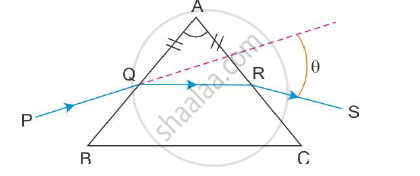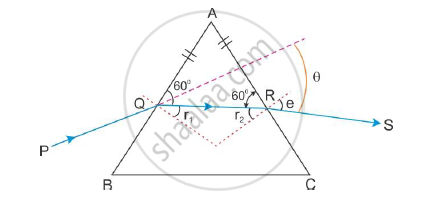Advertisements
Advertisements
Question
A ray PQ incident on the refracting face BA is refracted in the prism BAC as shown in the figure and emerges from the other refracting face AC as RS such that AQ = AR. If the angle of prism A = 60° and refractive index of material of prism is `sqrt3 `. Calculate angle θ.

Solution
The angle of the prism is A = 60°. It is also given that AQ = AR. Therefore, the angles opposite to these two sides are also equal.

∠AQR = ∠ARQ
Now, for a triangle
∠A + ∠AQR + ∠ARQ = 180°
∴ ∠AQR = ∠ARQ = 60°
∴ r1=r2 = 30° (∠AQO = ∠ARO = 90°)
∴ r1 + r2 = 60°
When r1 and r2 are equal, we have i = e. Now, according to Snell’s law,
`mu=sini/sinr_1`
`:.sini=musinr_1=sqrt3 sin30 =sqrt3/2`
∴ i = 60°
Now, the angle of deviation θ is
θ = i + e - A
∴ θ = 60 + 60 -60
∴ θ = 60°
APPEARS IN
RELATED QUESTIONS
Plot a graph to show the variation of the angle of deviation as a function of the angle of incidence for light passing through a prism. Derive an expression for the refractive index of the prism in terms of angle of minimum deviation and angle of the prism.
What is a dispersion of light
What is the cause of dispersion of light
A ray of light incident normally on one face of a right isosceles prism is totally reflected, as shown in fig. What must be the minimum value of refractive index of glass? Give relevant calculations.

State any two difference between the primary rainbow and secondary rainbow
Out of blue and red light which is deviated more by a prism? Give reason.
The minimum deviations suffered by, yellow and violet beams passing through an equilateral transparent prism are 38.4°, 38.7° and 39.2° respectively. Calculate the dispersive power of the medium.
A ray of light is incident on a prism whose refractive index is 1.52 at an angle of 40°. If the angle of emergence is 60°, calculate the angle of the prism.
In a regular prism, what is the relation between angle of incidence and angle of emergence when it is in the minimum deviation position?
When a ray of white light is incident obliquely on the first surface of a prism, then ______.
